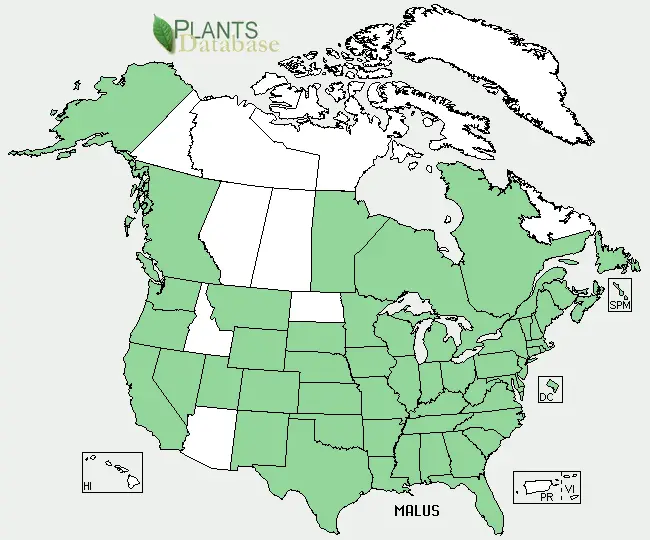
Search Wild Foods Home Garden & Nature's Restaurant Websites:
Crabapples

(NOTE: If you are not interested in growing Crabapples, but just finding and using them, try going to the Nature's Restaurant Online site for Crabapples.)
Crabapple (Malus). Like apples, these can be hit or miss. Some are very sharp or bitter, some are very good and quite nice to eat. You just have to experiment. People make jams and jellies from them, I just like to eat them fresh off the tree. I made a pie once from Crabapples. It was quite good, but a lot of work because you can't eat the seeds (poisonous) and the Crabapples are so small.
I don't think there really much of a difference technically between an "Apple" and a "Crabapple", in fact, one of the names for a Crabapple is "Wild Apple", and the Latin name of the "Apple" is Malus domestica, which means domestic Apple. That said, they are commonly treated differently in use, so I've given them a separate section. Color and size of fruit is also quite variable from red, to green, to yellow and mixtures of colors. Some are white inside, some are the same color inside as the skin. Often not as wormy as wild "Domestic Apples", so that is surely one big practical difference. Maybe I'm wrong, but I've never seen a red flesh, red skin "Apple", but that is common with the "Crabapples". I don't know if this is a common trait, but I've found in my experience that the larger sized (large marble as opposed to small marble sized) Crabapples with red flesh and red skin are the tastiest of the lot.
I have not been able to confirm this is universal or technically correct, but in my experience there are two ways to differentiate between an Apple and a Crabapple tree when not the season where there is fruit on the tree, or in season, and I'm not sure if it is a small Apple or a big Crabapple fruit. One way, look where the base of the leaf meets the stem - it is symmetrical with the Crabapple, but asymmetrical with the Apple. The second way is; Apples seem to come in ones from a branch, where Crabapples have two to a few coming together from the branch.
There is a wide range of Crabapples you can buy from nurseries, and if you want good tasting fruit that is larger in size, ask where they sell them. You could plant seeds, but remember, like Apples, it is a genetic lottery when planting seeds from the Malus genus. You most likely will end up with fruit that is not at all like the parent tree. Because of this, genetic lottery, this is one of those I suggest buying one that has the fruit that meets what you want from a nursery.
For information on growing Crabapples, go to the Apple section.
Description:
- USDA Plant Hardiness Zone: 4-8 (More information on hardiness zones).
- Soil pH: 5.0-6.8
- Plant Size: 4–12 meters (13 to 39 feet) tall
- Duration: Can live 80 years or more, but generally shows disease and degeneration after about 40 years
- Leaf Shape: Ovate
- Leaf Phyllotaxis (Arrangement) on branch: Alternate
- Leaf Size: 3–10 cm (1 1/5 to 4 inches) long
- Leaf Margin: Serrated (saw toothed edge)
- Leaf Notes: Leaf margins are very often wavy.
- Flowers: Five petalled flowers in clusters that can be white, pink or red
- Fruit: Small marble to large marble sized, looks like Apples, can be green, yellow, red or a mix of those colors, flesh can be white or color of skin
- Bark: Surprisingly varied. Young branches can be quite red to grey, with or without lenticels (checking), older bark can be smooth and grey to rough and broken up into plates, peeling back, or with vertical lines
- Habitat: Quite varied. Does not grow on acid soils.
Web Resources:
- Recipe search on the web here (Google search) and here (Bing search).
- Pictures on the web here (Google images) and here (Bing images).
- Interactive USDA distribution map and plant profile here.
- The Biota of North America Program (BONAP) distribution map here. BONAP map color key here.

Crabapple (Malus) range. Distribution map courtesy of U. S. Department of Agriculture (USDA Natural Resources Service) and used in accordance with their policies.

Notice that the flesh is the same color as the skin. In my experience these are better tasting.

These yellow Crabapples were so tart and dry they were basically not edible.

Notice this one has white flesh not matching the color of the skin. This one was very tart, but edible in small amounts.
Search Wild Foods Home Garden & Nature's Restaurant Websites:
Share:
Why does this site have ads?
Originally the content in this site was a book that was sold through Amazon worldwide. However, I wanted the information to available to everyone free of charge, so I made this website. The ads on the site help cover the cost of maintaining the site and keeping it available.
Google + profile
